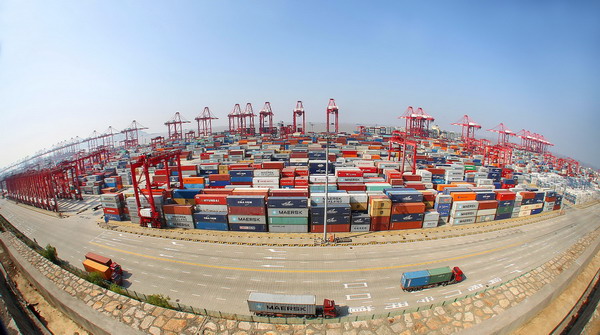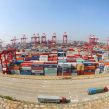
“Hope” versus “Hype”: Reforms in China’s Free Trade Zones
Publication: China Brief Volume: 15 Issue: 4
By:

The Chinese government’s decision to further liberalize its economy by establishing free trade zones (FTZ) has generated widespread optimism about the future of economic reform in China. The FTZ project, beginning with the creation of the Shanghai zone on September 29, 2013, is not only expected to carry forward the “Shenzhen spirit” but also spark wider and bolder economic reforms in China. Some of the new rules and regulations, launched for trial in the Shanghai FTZ, promise easier access to both foreign and domestic capital and the further opening up of the 18 service sectors in China. [1] The liberalizing measures for the financial sector, which is the most crucial of the reform initiatives, include free convertibility and overseas movement of the Renminbi, market determined interest rates and access for foreign finance institutions to establish foreign, as well as joint venture banks in China (China Free Trade Zone, September 18, 2013). As a means to encourage foreign investment, a new “negative list” approach has been adopted by the Shanghai FTZ to ease the process of investment approvals inside the zone (China Daily, November 22, 2014). [2] In addition, to promote better investment, the National People’s Congress has suspended three laws concerning foreign investment on a three-year trial basis and facilitated an installment mode to pay income tax for value-added assets in the Shanghai zone (China Business Registration, September 6, 2013). Vital to the promotion of market reforms are administrative reforms and, therefore, a host of other sectors are under consideration for further opening up to international standards, namely shipping services, trade and commerce services, professional services, social services and cultural services (Ministry of Commerce, January 10, 2014).
However, the significance of the Shanghai FTZ is not only limited to promoting regional trade and investment. Instead, the experiment represents a grander vision by Beijing to elevate China’s status to a full market economy, one that has been long pending in the World Trade Organization (WTO) and become a pivotal decision maker in the world economy. Given the difficulties that China faces in dealing with its major trade partners in the WTO rounds, the Shanghai pilot project can be seen as an attempt to lend credibility to China’s efforts to liberalize its economy in compliance with international standards and laws. Moreover, the purpose of establishing the Shanghai FTZ on a trial basis is to accumulate experience and extend the reform measures into other major port cities in order to drive further liberalization of the Chinese economy. Despite a high level of political support, uncertainty shrouds the future of the Shanghai pilot zone and there are real concerns as to whether the goals of the FTZ can be achieved as the Chinese state grapples with internal debates over the extent of relinquishing control of the economy to market forces.
Background: Early Initiatives to Free Trade Zones
The early initiatives for FTZs can be traced back to the process of gradually expanding China’s special economic zones into export processing zones, bonded zones and bonded port districts in the 1990s. These zones, which were “inside the territory but outside the customs,” eventually expanded to many port cities in China. The Waigaoqiao Free Trade Zone was established in Shanghai in 1991; twelve other bonded zones along the Chinese coast were developed in 1992 (China Daily, May 29, 1993). As a means to further intensify the process of reform and opening up, Mr. Cheng Siwei, Vice Chairman of the Standing Committee of the National People’s Congress, in 2003 proposed establishing FTZs in place of existing bonded zones (Beijing Review, September 03, 2013). Following the proposal, cities including Shanghai, Shenzhen and Tianjin filed applications to the State Council and its ministries for the establishment of FTZs.
Shanghai, often referred to as the “financial capital” of China, played a pivotal role in leading China through rapid economic growth and dynamism in the 21st century. As a result, the city has always enjoyed high levels of economic clout and political significance as compared to the other major port cities in China. To further underscore its importance in China’s economy, the Chinese central government in 2009 approved the Shanghai Municipal Government’s proposal to build the city into an international financial and shipping center by 2020 (Xinhua, April 24, 2009). This policy decision, motivated both by domestic economic and foreign policy concerns in the wake of the global financial crisis, was accompanied by a number of initiatives, including tax incentives, market liberalization measures and the gradual convertibility of the Chinese currency, in order to deepen its financial reform and transform its economic status to support China’s rising ambitions in the world order. Yet, it was only in 2013 that the proposed FTZ started gaining traction in China’s policy domain. In March 2013, Premier Li Keqiang visited the Waigaoqiao FTZ, and encouraged the local government to set up a pilot FTZ in Shanghai (Caixin, October 7, 2013). A mere five months later, the Shanghai FTZ was officially launched on a pilot basis, raising the curtain of transition in China on the post-liberalization era.
The New FTZs
For an export-led and labor-intensive economy like China’s, the effects of the 2008 global economic downturn were felt more strongly than is often realized. With its economic growth rate slowing, labor costs climbing and a rapid expansion of credit-to-GDP ratio, the need to adopt a sustainable model of development has intensified over the last several years. This provided the stimulus to deepen financial reform and create an economic structure in China led by both internal and external demand, which would allow China to reap benefits from international businesses while cushioning it from the worst excesses of external shocks. In this light, the Chinese government’s decision to build additional financial hubs after the Shanghai FTZ can be understood as a “finance-driven” reform approach to economic restructuring.
After a year of the Shanghai pilot FTZ, three new FTZs are now being established in the major sea-port cities of Guangdong, Tianjin and Fujian (South China Morning Post, December 13, 2014). Fujian is the closest mainland province to Taiwan, Tianjin specializes in international shipping and related sectors and Guangdong is adjacent to Hong Kong and Macao and is close to Southeast Asia. However, the troubles of the Shanghai FTZ—despite the personal high-level support of Premier Li—suggest that these new FTZs will face an uphill battle in expanding the grounds of economic liberalization in China.
Most Promises Stand Unfulfilled
China’s slowing growth has led many foreign companies to consider scaling back their expansion plans, and the Shanghai FTZ has failed to deliver on the promises of reform that appear necessary to justify foreign companies’ high hopes for a better future business environment in China. The new policies and regulations designed for the FTZ lack clarity to infuse enough confidence among the foreign ventures to enhance investment in China. In reality, after a year since the creation of the first FTZ in Shanghai, many crucial reforms on core issues of concern to foreign companies have hardly been implemented. For example, although several foreign banks have opened branches in the FTZ, they are not allowed to maintain independent interest rates separate from the Chinese government’s dictates and a key question remains whether any currency limit will be imposed while converting Renminbi in the FTZs.
Perhaps the biggest disappointment is the negative list, which has been revised to eliminate another 51 sectors (from 190 to 139). While the negative list has relaxed Chinese restrictions on foreign investment, mostly in manufacturing, transportation, real estate and wholesale retail, there has been no opening in telecommunication and finance sectors (China Pilot Free Trade Zone, July 16, 2014). Despite Premier Li’s slogans of liberalization and bolder market reforms, new rules for the FTZs on value added telecommunication services (VATS) have failed to satisfy foreign companies (Shanghai Daily, July 19, 2014). Except for combining the pre-approval and VATS Permit application procedures, the new measures are hardly a deviation from the standard requirements set up by China’s Ministry of Industry and Information Technology for the rest of China. With respect to the foreign investment regime in China, although the potential policy impact of the suggested amendments in the Foreign Investment Enterprise laws (FIE) remain high, very little has been done in that direction (Shanghai Daily, September 29, 2013).
The slow progress of the Shanghai FTZ is due in large part to Chinese domestic politics under Chinese President Xi Jinping. First, as the Chinese leadership proposes market reform initiatives, it faces strong opposition from state-owned enterprises, monopolies and private groups whose interests seem to be threatened at the hands of market forces. Second, there is tremendous pressure on both President Xi and Premier Li to balance between the ultra-leftists, who consider foreign firms and foreign investment to be corrupting forces, the reform minded liberals, who reject the outdated framework of a planned economy, and opportunists, who try to protect the interests of those they regulate. The leadership cannot afford a direct confrontation with any group. Therefore, it is becoming difficult to reach consensus on new policy initiatives and priorities, thus preventing effective policy implementation in the FTZs. Third, the anti-corruption drive of the new leadership has turned the local officials in charge of the FTZs risk-averse, and they are quite hesitant to pursue independent experiments to meet the growth targets issued by Beijing. They have become extra-cautious after the removal of Dai Haibo, deputy chief of the Shanghai FTZ managerial committee, on grounds of disciplinary violations (Xinhua, September 16, 2014). Yet another challenge for the Shanghai FTZ is to garner enough consensus support to regain the independence necessary to successfully experiment with new policy initiatives.
Conclusion
The new phase of economic reforms, tied to this slate of new FTZ initiatives, is based on the neoliberal promise that free markets and reduced bureaucracy will bring prosperity to China’s stagnating economy. The Third Plenum of the 18th Party Congress, held in November 2013, endorsed this commitment to reform in the name of “comprehensive reform” to keep the economy growing. China’s new FTZs are intended to promote higher levels of foreign trade and investment through preferential tax policies, deregulation and more sectors open to foreign companies. However, in reality, these FTZ reforms remain largely rhetorical, and foreign companies are waiting for Shanghai to live up to its promise.
Notes
- Shenzhen was the first special economic zone established in the year 1980 as part of Deng Xiaoping’s “opening up” strategy. In about 30 years, Shenzhen has transformed itself into the cradle of China’s dramatic transformation into a world economic and trade juggernaut.
- A “negative list” is a list of industries where foreign investment is restricted or prohibited. Foreign investors proposing to invest in industrial sectors identified on the negative list are subject to close scrutiny, and prior government approval would be required before any investment may take place. This is a change from China’s traditional practice of screening all foreign investment.





